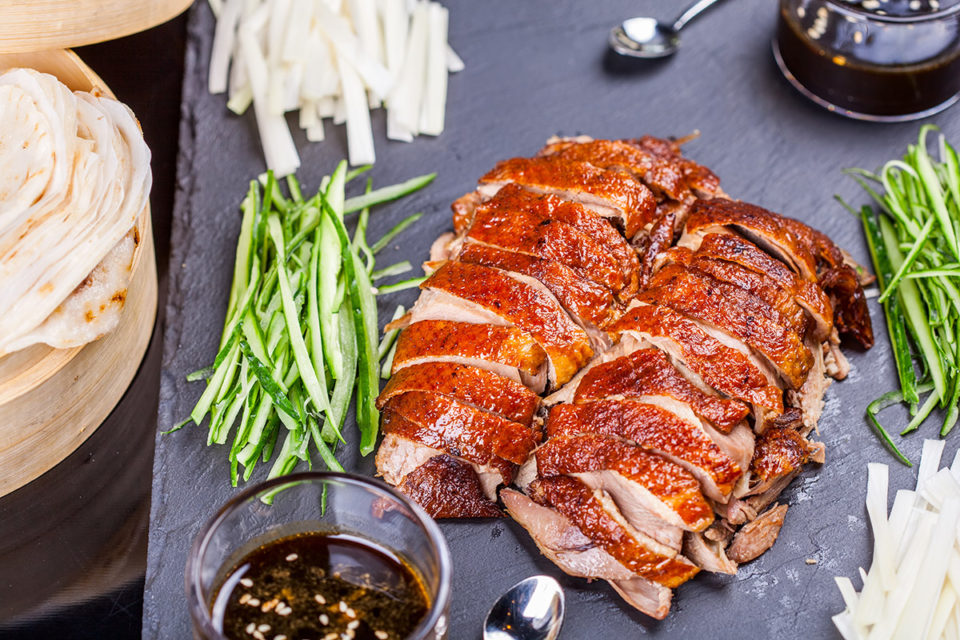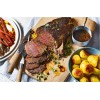A famous Chinese food: Peking duck
Peking duck is a dish from Beijing (Peking) that has been prepared since the imperial era. The meat is characterized by its thin, crisp skin, with authentic versions of the dish serving mostly the skin and little meat, sliced in front of the diners by the cook. Ducks bred specially for the dish are slaughtered after 65 days and seasoned before being roasted in a closed or hung oven. The meat is often eaten with spring onion, cucumber and sweet bean sauce with pancakes rolled around the fillings. Sometimes pickled radish is also inside, and other sauces (like hoisin sauce) can be used.
History
Duck has been roasted in China since the Southern and Northern Dynasties. A variation of roast duck was prepared for the Emperor of China in the Yuan Dynasty. The dish, originally named "shāo yāzi", was mentioned in the Complete Recipes for Dishes and Beverages (饮膳正要) manual in 1330 by Hu Sihui (忽思慧), an inspector of the imperial kitchen. The Peking Roast Duck that came to be associated with the term was fully developed during the later Ming Dynasty, and by then, Peking Duck was one of the main dishes on imperial court menus. The first restaurant specializing in Peking Duck, Bianyifang, was established in the Xianyukou, close to Qianmen of Beijing in 1416.
By the Qianlong Period (1736–1796) of the Qing Dynasty, the popularity of Peking Duck spread to the upper classes, inspiring poetry from poets and scholars who enjoyed the dish. For instance, one verse of Dūmén zhúzhīcí, a Beijing local poem was, "Fill your plates with roast duck and suckling pig".
In 1864, the Quanjude (全聚德) restaurant was established in Beijing. Yang Quanren (杨全仁), the founder of Quanjude, developed the hung oven to roast ducks. With its innovations and efficient management, the restaurant became well known in China, introducing the Peking Duck to the rest of the world.
By the mid-20th century, Peking Duck had become a national symbol of China, favored by tourists and diplomats alike. For example, Henry Kissinger, the Secretary of State of the United States, met Premier Zhou Enlai in the Great Hall of the People on July 10, 1971, during his first (secret) visit to China. After a round of inconclusive talks in the morning, the delegation was served Peking Duck for lunch, which became Kissinger's favourite. The Americans and Chinese issued a joint statement the following day, inviting President Richard Nixon to visit China in 1972. Following Zhou's death in 1976, Kissinger paid another visit to Beijing to savor Peking Duck. Peking Duck, at the Quanjude in particular, has also been a favorite dish for various political leaders ranging from Cuban Fidel Castro to former German chancellor Helmut Kohl.
Two notable restaurants in Beijing which serve this dish are Quanjude and Bianyifang, both centuries-old establishments which have become household names, each with their own style: Quanjude is known for using the hung oven roasting method, while Bianyifang uses the oldest technique of closed oven roasting.
Style
1. Closed-oven style
Peking duck is originally roasted in a closed oven (Chinese: 焖炉), and Bianyifang is the restaurant that keeps this tradition. The closed oven is built of brick and fitted with metal griddles (Chinese: 箅子; pinyin: bì zi). The oven is preheated by burning Gaoliang sorghum straw (Chinese: 秫秸; pinyin: shú jiē) at the base. The duck is placed in the oven immediately after the fire burns out, allowing the meat to be slowly cooked through the convection of heat within the oven. Controlling the fuel and the temperature is the main skill. In closed-oven style, duck meat is combined well with the fat under the skin and therefore is juicy and tender.
2. Open-oven style
The open oven (Chinese: 挂炉; literally: "hung oven") was developed in the imperial kitchens during the Qing Dynasty, and adopted by the Quanjude restaurant chain. It is designed to roast up to 20 ducks at the same time with an open fire fueled by hardwood from peach or pear trees. The ducks are hung on hooks above the fire and roasted at a temperature of 270 °C (525 °F) for 30–40 minutes. While the ducks are roasting, the chef may use a pole to dangle each duck closer to the fire for 30-second intervals. In open-oven style, the fat is usually melted during the cooking process, so the skin is crispy and can be eaten separately as a snack.
Almost every part of a duck can be prepared afterward. Quanjude Restaurant served their customers the "All Duck Banquet" in which they cooked the bones of ducks with vegetables.
Recipe
1 (4 pounds) whole duck, dressed
1/2 teaspoon ground cinnamon
1/2 teaspoon ground ginger
1/4 teaspoon ground nutmeg
1/4 teaspoon ground white pepper
1/8 teaspoon ground cloves
3 tablespoons soy sauce
1 tablespoon honey
1 tablespoon chopped fresh parsley, for garnish
5 green onions
1/2 cup plum jam
1 1/2 teaspoons sugar
1 1/2 teaspoons distilled white vinegar
1/4 cup finely chopped chutney
1. Rinse the duck inside and out, and pat dry. Cut off the tail and discard. In a small bowl, mix together the cinnamon, ginger, nutmeg, white pepper and cloves. Sprinkle one teaspoon of the mixture into the cavity of the duck. Stir one tablespoon of the soy sauce into the remaining spice mixture and rub evenly over the entire outside of the bird. Cut one of the green onions in half and tuck inside the cavity. Cover and refrigerate the bird for at least 2 hours, or overnight.
2. Place duck breast side up on a rack in a big enough wok or pot and steam for an hour adding a little more water, if necessary, as it evaporates. Lift duck with two large spoons, and drain juices and green onion.
3. Preheat the oven to 375 degrees F (190 degrees C). Place duck breast side up in a roasting pan and prick skin all over using a fork.
4. Roast for 30 minutes in the preheated oven. While the duck is roasting, mix together the remaining 2 tablespoons of soy sauce and honey. After 30 minutes, brush the honey mixture onto the duck and return it to the oven. Turn the heat up to 500 degrees F (260 degrees C). Roast for 5 minutes, or until the skin is richly browned. Do not allow the skin to char.
5. Prepare the duck sauce by mixing the plum jam with the sugar, vinegar and chutney in a small serving bowl. Chop remaining green onions and place them into a separate bowl. Place whole duck onto a serving platter and garnish with orange slices and fresh parsley. Use plum sauce and onions for dipping.
Related Articles
Search
Categories
Popular Posts





















Comments: 0
No comments